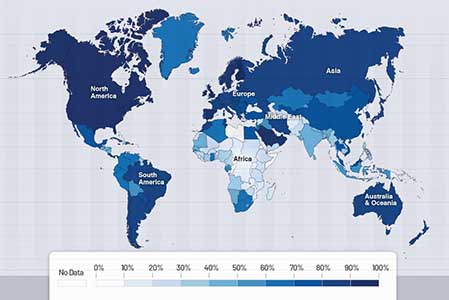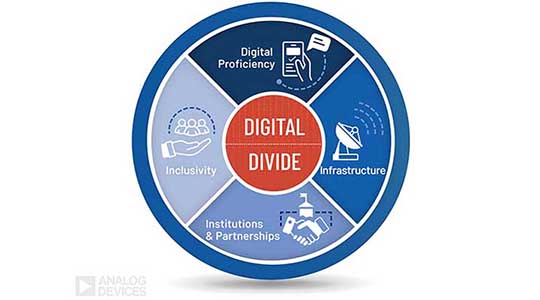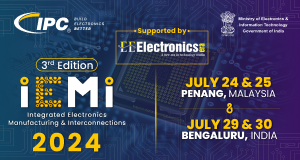
Once, high speed internet connectivity was considered a luxury. Today, it’s a necessity—an essential tool for education, communications, and business. Students need internet access to do homework, seniors to televideo with their doctors, and businesses to communicate with customers. Those without high speed connectivity to the internet via cable, satellite, or wireless 4G and 5G are at a socioeconomic disadvantage, as they are significantly less able to gain new skills, find and apply for jobs, and shop and sell online.

THE DIGITAL DIVIDE: A WORLDWIDE PROBLEM
The digital divide is the gap between those who have access and connectivity to digital technology with the skills to use the tools—and those who do not. The gap is not limited by any region, country, social, economic, class, race, or gender. Estimates by reliable sources vary, but approximately a third to half of the world’s population are caught on the wrong side of the digital divide,1 disconnected from opportunities and a wide range of essential services the rest of us rely on and take for granted.
3.7 Billion
PEOPLE WITHOUT INTERNET ACCESS, ALMOST HALF THE GLOBAL POPULATION.2
ADI is a global technology company with global concerns. We are committed to helping solve the world’s toughest challenges. Bridging the digital divide is about figuring out how we and our partners can innovate and enable affordable communications technology to reach those who need it most. We are committed to the advancement of this goal, which reinforces our purpose to work for the engineering good.
HOW WIDESPREAD IS THE DIGITAL DIVIDE?
The statistics are startling
Worldwide, only 55% of households have an internet connection, and 1.5 billion individuals reside in areas without high speed mobile data coverage.3 People who live in rural and remote areas, women, and the poor are the largest segments without access. The majority of those lacking access live in developing regions of the world, where in the poorest nations, only 20% have a connection.4

The gap exists everywhere
Importantly, the digital gap also exists in technologically rich developed nations and urban centers across the globe. 1.75 billion citizens in the world’s eight richest countries (by GDP) remain unconnected—with 34% (approximately 600 million people) residing in major urban centers.6 “We’ve been working with communities in Queens, in the middle of New York City, and seen similar problems in California, right outside of Los Angeles. It’s a problem that affects all geographies, regardless of whether it’s urban, rural, or domestic,” said Justin Dent, Executive Director, Outschool.org, an organization that brings education to students via the internet.
42 Million
THE NUMBER OF PEOPLE WITHOUT BROADBAND ACCESS IN THE U.S.7
A COMPLEX PROBLEM
The digital divide is a complicated issue, entwined in the fabric of societal problems and socioeconomics. It lies at the center of numerous major issues, ranging from racial inequality, income disparity, and gender bias.
Race
The digital divide reinforces racial inequity. In the U.S., 80% of White adults report having a broadband connection at home, compared to 71% of Black adults and 65% of Hispanic adults. 63% of Black adults compared with 49% of White adults say not having high speed internet is a major disadvantage when it comes to connecting with medical professionals.8
Income
Poor neighborhoods often lack the telecommunications infrastructure available in more affluent ones. These disadvantaged communities are often seen as less attractive for investment by communications companies, further deepening the divide. Roughly, a quarter of individuals in the U.S. with yearly average earnings under $30,000 (24%), say they don’t own smartphones. Four out of every ten low-income people (43%) do not have home internet or computer access. (43%).9
Access
The digital divide is more than just an infrastructure coverage issue. Some 3.6 billion people in developing countries do not have the necessary devices to access the internet—computers, tablets or internet ready cell phones. Access to the internet ranges from a high of 76.4% for Central Asia to a low of 14.3% for Africa.10
Gender
The digital divide affects women disproportionately. The digital gender divide continues to be a barrier to meaningful participation in today’s digital society. According to ITU’s latest data, the proportion of women using the internet globally is 57%, compared to 62% of men.
Digital Literacy
The inability to use digital tools reduces access to important essential services for many people worldwide, including millions of Americans. 70% of Black and 60% of Hispanic people in the U.S. report being underprepared with digital skills—competencies that affect their employability.12 Improving digital literacy is key to unlocking social mobility, economic equality, and economic growth for approximately 30% of the world. Without these skills, investment in infrastructure expansion alone has a diminished effect.
Cost
The price of connecting can be prohibitive. A one-hour Zoom video call with average internet speed on a mobile plan in the U.S. costs about $4, based on data collected by UK-based research firm Cable UK. However, that same call would cost about $14 using mobile data in Benin and Malawi, both in Africa.11 Here, the cost impact is even more significant, given the comparatively lower incomes. According to the World Bank, 85% of Africans live on less than $5.50 a day. To put it all in perspective, according to the UN, affordable internet is defined as no more than 2% of a person’s monthly income per gigabyte of data.11
THE GAP IN EDUCATION
According to the Pew Internet & American Life Project, “The digital divide has especially far-reaching consequences when it comes to education. For children in low-income school districts, inadequate access to technology can hinder them from learning the tech skills that are crucial to success in today’s economy.” It’s a worldwide issue, not limited to just the developing world. For example, only 68% of Australian children aged 5 to 14 living in disadvantaged communities have internet access at home, compared to 91% of students living in advantaged communities.13
“In a society where increasingly we are defined by access to information and what we earn is what we learn, if you don’t have access to technology, you’re going to be left in the digital dark ages.”
William Kennard, Former Chair of the FCC
THE HOMEWORK GAP: DIVIDE IN U.S. EDUCATION

40% of Schools
The number of K-12 educational institutions in the U.S. that lack connectivity to high speed broadband.14
70% of Kids
The percentage of children in the Kansas City School District who do not have internet access at home.15
50% of Students
Percentage of students in the U.S. unable to finish their homework due to an inability to connect or find a computer.16
59% of children from lower-income families in the U.S. faced obstacles in completing assignments, according to the Pew Research Center. Some only had access to a cellphone to complete homework, others needed public WiFi access because of unreliable service in the home, and many lacked access to a computer at home (21%).17
THE ECONOMIC COST AND OPPORTUNITY
“Those who find themselves on the wrong side of the digital divide suffer further economic, social, health, and political disparities resulting from disconnection,” said Jordana Barton of the Federal Reserve Bank of Dallas. Since broadband access has become increasingly essential, any community without fast, reliable internet is condemned “to a long, dark death”, said Peggy Schaffer, Executive Director of Maine’s ConnectME Authority.
Broadband access drives business development and a better life
Whether delivered by terrestrial wired or wireless networks or via satellite, access to reliable, fast internet connectivity is a strong predictor of economic opportunity.18 Broadband infrastructure is needed to deliver an ecosystem that supports entrepreneurship and enables businesses to expand market reach and customer base.
Charting a course for closing the gap
Bridging the digital divide is more than just a connectivity issue. While technical infrastructure is an essential ingredient, enabling meaningful access through inclusivity and digital literacy of the user is equally important. Institutions, local, regional, and national governments, and corporations can play an important role, providing strategy, funding, and programs promoting access and adoption.+
Digital Divide’s Four Components

Digital Proficiency
How well one navigates the digital world, shaped by demographic profile, education levels, and technology training.
Infrastructure
Internet speeds; terrestrial broadband coverage; smartphone usage.
Institutions and Partnerships
Political prioritization of broadband strategy. Corporate participation.
Inclusivity
Affordability; equity of broadband access across income groups.
A CONNECTED WORLD

We are on a course of unlimited potential. As new metaverse technologies such as the internet of things (IoT), virtual reality (VR), vital signs monitoring (VSM) wearables, augmented reality (AR), and smart city networks become increasingly common, the worldwide benefits of digital transformation will become even more pronounced. Those without access or connectivity will not only miss out on the key resources and services, but also on long-term economic, education, and health care benefits that technology innovation bring.
Our ever-expanding digitized world holds the possibility for universal connectivity or continued isolation for the digital divided. Government, private industry, and NGOs must align to improve digital literacy to extend the internet for all people by finding creative new business models and partnerships to increase affordability, expand infrastructure, and extend access for the whole world.
About Analog Devices and the Digital Divide
- ADI is dedicated to bridging the digital divide and working with customers and partners to help provide opportunities for all. Here are some ways in which ADI’s technology breakthroughs continue to have impact:
- Developed power management technology for one of the world’s first 5G cell towers now serving millions in South Korea.
- Helped evolve phased array space communications to beam affordable access to land-locked communities in Africa and Asia.
- Encouraged ecosystem diversity, innovation, and open-access infrastructure sharing to help bring wired, wireless, space, and mobile connectivity to a third of the world’s population.

Vice President, Wireless Communications Business Unit
Analog Devices
AUTHOR DETAILS
Joe Barry is the Vice President of the Wireless Communications Business Unit at Analog Devices. He is responsible for the Wireless Market Segment, along with the technology groups of high speed converters, SDR transceivers, and microwave communications. For more than 26 years, Joe has served in leadership roles in the wireless communications, consumer, and semiconductor industry. He earned a B.Eng. in electrical and electronic engineering from University of Greenwich and an MBA from the University of Limerick. Joe holds five patents in analog and digital video and audio technologies.
References
1 “With Almost Half of World’s Population Still Offline, Digital Divide Risks Becoming ‘New Face of Inequality’, Deputy Secretary-General Warns General Assembly.” United Nations, April 2021.
2 “Strengthening Ties for Affordable Connectivity Worldwide.” United Nations.
3 “With Almost Half of World’s Population Still Offline, Digital Divide Risks Becoming ‘New Face of Inequality’, Deputy Secretary-General Warns General Assembly.” United Nations, April 27, 2021.
4Douglas Broom. “Coronavirus Has Exposed the Digital Divide Like Never Before.” World Economic Forum, April 22, 2020.
5“Digital Divide throughout the World and Why It Causes Inequality.” Iberdrola.
6“Digital Inclusion–Key to Prosperous & Smart Cities.” Wireless Broadband Alliance, 2017.
7John Busby, Julia Tanberk, and Tyler Cooper. “BroadbandNow Estimates Availability for All 50 States; Confirms That More than 42 Million Americans Do Not Have Access to Broadband.” BroadbandNow Research, May 5, 2021
8Sara Atske and Andrew Perrin. “Home Broadband Adoption, Computer Ownership Vary by Race, Ethnicity in the U.S.” Pew Research Center, July 16, 2021.
9 Emily A. Vogels. “Digital Divide Persists Even as Americans with Lower Incomes Make Gains in Tech Adoption.” Pew Research Center, June 2021.
10George Ingram. “Bridging the Global Digital Divide: A Platform to Advance Digital Development in Low- and Middle-Income Countries.” Brookings Global Working Paper #157. Brookings Institution, June 2021
11Orion Wilcox. “Visualizing the Global Digital Divide.” DT Global, March 4, 2021
12Marke David Brancaccio, Candace Manriquez Wrenn, and Daniel Shin. “The U.S. Has a “Racial Tech Gap” Problem, Deutsche Bank Study Shows.” Marketplace.org, Sept 18, 2020.
13 “Schools Are Moving Online, but Not All Children Start Out Digitally Equal.” The Conversation, March 26, 2020.
14Joyce Winslow. “America’s Digital Divide.” PEW Charitable Trust, Summer, 2019
15Bhaskar Chakravorti. “How to Close the Digital Divide in the U.S.” Harvard Business Review, July 20, 2021.
16 Clare McLaughlin. “The Homework Gap: The ‘Cruelest Part of the Digital Divide’.” NEA Today, April 20, 2016.
17Emily A. Vogels. “59% of U.S. parents with lower incomes say their child may face digital obstacles in schoolwork.” Pew Research Center, September 10, 2020.
18Karen Mracek. “What Is the Impact of the Digital Divide?” Federal Reserve Bank of St. Louis, November 6, 2018.












